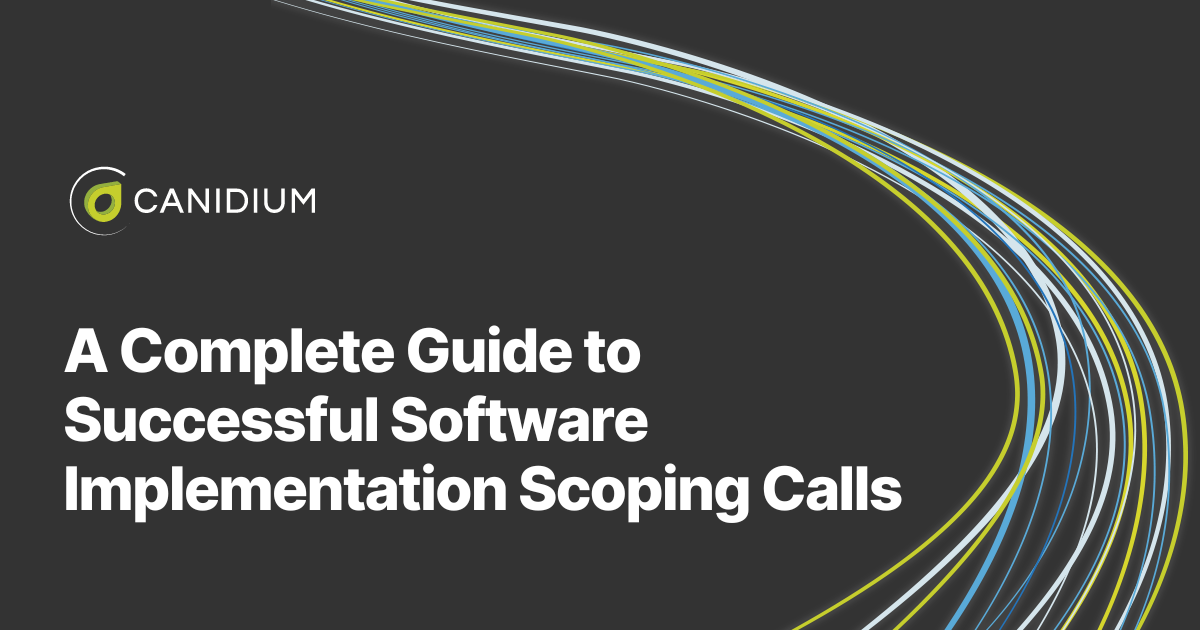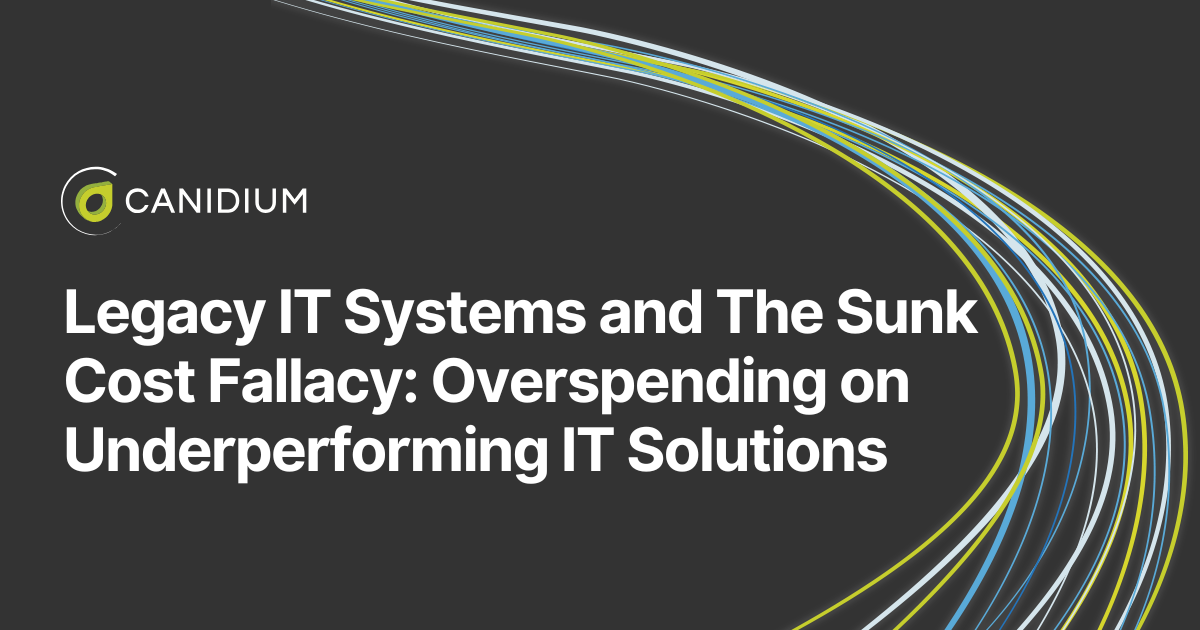Sales performance management software paves the way for innovation and efficiency in a sales-driven organization. The scoping call with a potential software implementation (SI) partner is one pivotal stage that can make or break an implementation.
This initial interaction with a potential SI partner can set the tone for the entire project, making knowing what information to show up with and addressing the common problems that often surface during such discussions imperative.
Canidium scoping calls are notoriously detailed and exploratory. We do this in order to create a complete project summary and limit the need for CRs down the road. This necessitates that our clients must be prepared with the right information.
This article provides:
- A complete list of materials you should come to a scoping call prepared with
- Ten challenges organizations may encounter during scoping calls
A complete list of what an organization needs to have a successful scoping call with an SI partner
To ensure a successful software implementation scoping call, it's essential to come prepared with various materials that will help facilitate a comprehensive discussion. Here's a list of materials to consider bringing to the scoping call:
Project Overview: High-level description of the project, its goals, and its significance.
Business Requirements Document: Detailed document outlining the business requirements for the software solution.
Technical Requirements Document: Technical specifications, including specific technologies, platforms, or frameworks that should be used.
Existing Documentation: Any documentation related to the project, such as design documents, architecture diagrams, or process flows.
Budgetary Information: Clear understanding of budget and financial considerations for the project.
Team Structure: Information about internal team members who will be involved in the project, including their roles and responsibilities.
Decision-Making Process: Clarification of the decision-making process within the organization, including key stakeholders and decision-makers.
Preferred Communication Channels: Communication preferences and expectations, including preferred channels, frequency of updates, and reporting requirements.
Integration Requirements: Any integration points with existing systems or third-party applications.
Security and Compliance Requirements: Security and compliance requirements that the software solution must adhere to.
Testing and Quality Assurance Requirements: Requirements and expectations for testing, quality assurance, and specific testing environments.
Post-Implementation Support: Expectations for post-implementation support, including bug fixes, updates, and ongoing maintenance.
Regulatory Considerations: Any regulatory considerations or industry-specific standards that must be followed.
Previous Challenges or Lessons Learned: Insights into previous challenges or lessons from similar projects.
Questions for the Implementation Partner: Prepare specific questions or concerns you want to discuss with the potential implementation partner.
Technology Stack Preferences: Clearly articulate any preferences regarding the technology stack used in the project.
Legal and Contractual Information: Any legal or contractual information that needs to be discussed, such as confidentiality agreements or terms and conditions.
By having these materials ready, you demonstrate thorough preparation and provide the implementation partner with the necessary information to understand the project's scope and requirements. This, in turn, contributes to a more focused and productive scoping call.
10 Problems an organization could face during an SI scoping call and their solutions
While scoping calls for software implementation are essential for clearly understanding the project, various challenges can arise during these discussions. Here are some common problems associated with scoping calls and potential ways to address them:
Problem #1
Lack of Clarity on Requirements: Incomplete or ambiguous project requirements can lead to misunderstandings between the organization and the implementation partner.
Solution
Thoroughly Document Requirements: Create comprehensive project requirements documentation before the scoping call. Ensure that all stakeholders are aligned on the documented requirements.
Problem #2
Misalignment of Expectations: Differences in expectations regarding project scope, deliverables, timelines, or budget may arise.
Solution
Clarify Expectations: Communicate expectations regarding project scope, deliverables, timelines, and budget in advance. Regularly revisit and confirm these expectations during the scoping call.
Problem #3
Insufficient Preparation: Either party may come unprepared, lacking relevant information and a less productive discussion.
Solution
Preparation Checklist: Develop a checklist of materials and information required for the scoping call. Share this checklist with all parties involved to ensure everyone comes prepared.
Problem #4
Limited Stakeholder Involvement: Key stakeholders may not be present during the scoping call, leading to decisions being made without crucial input.
Solution
Involve Key Stakeholders: Ensure key stakeholders are present during the scoping call. Their input is crucial for making informed decisions and avoiding misunderstandings.
Problem #5
Inadequate Understanding of Technology: The organization or the implementation partner may lack a clear understanding of the technology stack or requirements.
Solution
Technology Briefing: Conduct a technology briefing before the scoping call to ensure that both parties clearly understand the technology stack and any technical requirements.
Problem #6
Scope Creep: There's a risk of scope creep, where additional requirements are introduced during the scoping call without proper evaluation.
Solution
Clearly Define Project Scope: Define and document the scope before the scoping call. Establish a change control process to manage scope changes effectively.
Problem #7
Unrealistic Timelines or Budgets: Unrealistic project timelines or budget constraints may be proposed, leading to challenges during implementation.
Solution
Realistic Timelines and Budgets: Provide realistic estimates for project timelines and budgets. Discuss the factors influencing these estimates and be transparent about any constraints.
Problem #8
Language or Cultural Barriers: Communication issues may arise due to language barriers or cultural differences between the organization and the implementation partner.
Solution
Effective Communication: Produce effective communication by proactively addressing language barriers or cultural differences. Encourage open dialogue and create an inclusive environment.
Problem #9
Failure to Address Risks: Risks associated with the project may not be adequately discussed, leading to potential issues later.
Solution
Risk Identification and Mitigation: Explicitly discuss potential risks during the scoping call. Collaboratively identify risk mitigation strategies and contingency plans.
Problem #10
Incomplete Data Sharing: One party may not share all relevant information, hindering a comprehensive understanding of the project.
Solution
Transparency and Information Sharing: Promote transparency by encouraging open sharing of information. Create an environment where both parties feel comfortable discussing challenges, constraints, and concerns.
Addressing these common problems during scoping calls can contribute to more successful software implementation partnerships, helping to establish a solid foundation for collaboration and project success.
By implementing these strategies, you can enhance the effectiveness of scoping calls and set the stage for a successful software implementation partnership. Open communication, thorough preparation, and a commitment to addressing potential challenges can contribute to a clearer understanding of the project and help avoid many common pitfalls. Maintaining ongoing communication and collaboration throughout the project lifecycle is essential for its success.
Are you prepared for your software implementation project scoping call?
The journey to seamless integration begins with the scoping call with a potential Software Implementation (SI) partner. This initial interaction, which has the potential to shape the entire project, requires a keen eye for addressing common problems that often emerge during these discussions.
This article unraveled ten challenges organizations may confront during software implementation scoping calls and presents practical solutions to navigate these intricacies effectively. From the complexities of unclear requirements to the subtleties of mitigating hidden risks, our exploration serves as a comprehensive guide, offering insights and strategies to foster open communication, thorough preparation, and a steadfast commitment to overcoming potential challenges.
By proactively understanding and tackling these issues, organizations can significantly enhance the effectiveness of scoping calls, laying a foundation for a successful implementation. With this detailed list of materials necessary for a scoping call, your organization can create an effective software solution with your SI partner.
Now that you have read this guide, you are ready for your scoping call with your SI partner candidate.
You can continue your education on the implementation process by reading this article: A Complete Guide to Software Implementation Scope of Work (SoW).








